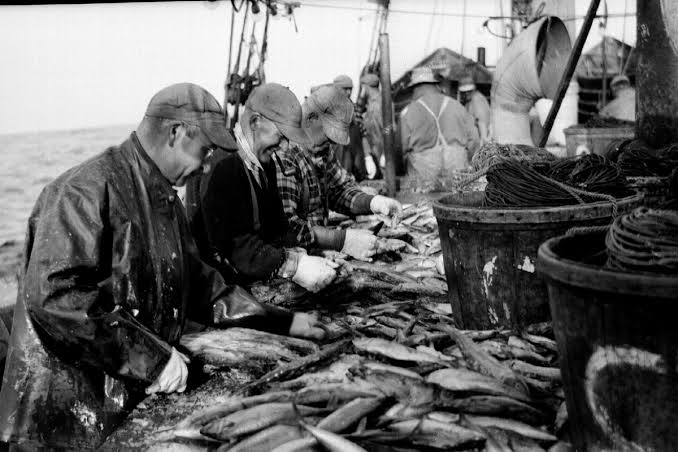Groundfishing – the catching of fish that swim close to the bottom – was the first colonial industry in America. This history, written in the 1990s, looks back to the beginnings of the 20th century and follows the development of groundfishing over the years.
Groundfishing, the catching of fish that swim in close proximity to the bottom, was the first colonial industry in America. During the past 400 years, changes in the methods, people and productivity of groundfishing have paralleled the technological, ethnographic and environmental conditions ashore. Now we are faced with unprecedented low stocks of groundfish species, and an industry shrinking in regional importance, struggling to support historical fishing communities such as Gloucester and New Bedford, Massachusetts.
This review is intended to look back to the beginnings of the 20th century, and to follow the development of groundfishing to the current times. Many of the problems currently faced by the industry were foreseen as early as the first decade of the new century. Increasingly efficient fishing methods, competition between fleet sectors employing various gears, inability to act in harmony with international partners, and the failure to heed scientific advice sound like current themes, but in fact have been echoed repeatedly since the turn of the century. The diversity and productivity of New England fisheries was once unequaled. A continuing trend over the past century has been the overexploitation and eventual collapse of species after species. Atlantic halibut, ocean perch, haddock and yellowtail flounder once fed millions of Americans. Now even the venerable Atlantic Cod, resilient to years of overfishing, could join the ranks of species written-off as commercially extinct. How we came to the current situation, and missed opportunities to put the fishery on a sustainable basis form the thesis of this review. Understanding the historical, scientific and human dimensions that influenced the fish, fishermen and management decisions is a necessary step to begin harmonizing the fishery with the ecosystem. Introduction The fishing industry of New England has, for over 400 years, been identified both economically and culturally with groundfishing. A mixture of bottom-dwelling fish including cod, haddock, redfish and flounders constitute the groundfish resource. Once, great fleets of vessels sailed from Gloucester and Boston to the eastern- most reaches of North America — the Grand Banks of Newfoundland. Catches of salt cod supported nearly 400 schooners in each of these ports, and a multitude of shore-side businesses including salt mining, ice harvesting in fresh-water ponds, and a boat building industry that made the shipyards on the Essex River among the busiest and best known in the world. The industrial revolution caught up with the fishing industry around the turn of the century. The introduction of the steam- powered trawler from England heralded a sea change in how groundfish were caught, and rapidly replaced the schooner fleets. More over, the community and social dynamics of fishermen was changed forever. Even then there was concern that the new technology was quite powerful, and could threaten the productivity of the stocks. Scientific investigations of the time warned that the new technology should be applied judiciously – but had little effect on fishing. By 1930 there were clear signs that the fleet had grown too efficient in relation to the capacity of the stocks to sustain growth in landings. A new round of scientific investigation, begun in 1930 at Harvard University, showed just how powerful the new technology was. In 1930 the fishery landed 37 million haddock at Boston, with another 70-90 million baby haddock discarded dead at sea! The very small mesh size used in the nets was judged the culprit. Yet not until 1953 did the first regulations specifying the minimum mesh size for trawl nets come into force.
Prior to WW II the fleet was large in size, but profitability was low. Consumption of fish in America had nose-dived as the daughters and sons of immigrants abandoned old-world traditions of fish consumption. The war years were again prosperous for the industry as fish was canned for the GIs, and protein demands and rationing necessitated a return to fish consumption. The fleet was reduced at this time, as many of the largest trawlers were requisitioned for war duty as mine sweepers. The return of these vessels from war, along with reduced demand resulted again in hard times in the industry. Development of new markets such as selling ocean perch in the midwest as a substitute for Great Lakes yellow perch sustained the offshore fleet. Many government subsidy programs, that would come back to haunt the industry decades later, were launched after the war. The beginning of the 1960s saw the development of the gravest threat yet to the sustainability of the fishery. Ocean-going fish factories, comprising the distant water fleets ‘discovered’ haddock, hake and herring resources off Georges Bank. Soon fleets from the USSR were joined by those from East Germany, Poland, Spain, Japan and others. Not until the early 1970s could an international commission settle on fishing restrictions, too late to avoid the virtual collapse of most groundfish stocks. The clamor for the U.S. to assert control over waters out to 200 miles was great. Congress enacted the Magnuson Act of 1976, taking control of the exclusive economic zone (EEZ), and setting up a system of regulation of the domestic industry. Fueled by great expectations and aided by subsidy programs in place since the 1950s, the U.S. began to build new, modern fishing boats. The fleet, once dominated by wooden side-trawlers, was replaced quickly with steel stern-trawlers, miniature versions of the factory trawlers used by the distant water fleets. Quota-based regulations, a hold-over from the last days of international restrictions, seemed to be in the way of the revitalized U.S. groundfish fleet. Catch quotas — a method of directly controlling the percentage of the stock harvested each year — were discontinued in favor of what proved to be ineffective measures to control the size of meshes in the nets, and the minimum length of fish landed. The high water mark for the industry in the post-200 mile limit era occurred in the early 1980s, when strong year classes of cod and haddock, spawned in 1975 and 1978, became harvestable size. These resources were scooped up, this time by those who had seen same damage caused by the distant water fleets. Resources have since declined to levels lower than those recorded during the era of the DWFs. Now the clamor for regulation comes not just from the fishermen, but from environmental groups, the general public and elected officials. Years of supporting industry growth have left the federal government vulnerable to charges that its policies helped collapse the fish stocks, and harmed the environment. Congress has begun to develop programs to help failing fishing communities through vessel buy-outs, job retraining, and subsidized health insurance for fishing families. Outline and Period Synopses The history of 20th century groundfishing in New England can be divided into six time periods, based on a combination of factors including technological development, changes in species abundance, development of markets for new species, or improved marketing of existing fish, and major changes in the regulatory regime. Some of these factors span more than one time period (e.g. shift from cod to haddock as the primary target species), whereas others were single events, so dominating the scene that they are clearly demarcate new eras (e.g. passage of the Magnuson 200-mile limit law in 1976). The intent of these chapters is to describe and illustrate the periods from three separate perspectives: the industry (e.g. people and commerce), the fish (biology), and management institutions (political and institutional).
Period 1. Sail to Steam (1900-1920)
Prior to the introduction of steam trawling in 1906, groundfish were caught exclusively with baited lines, fished from schooners and their dories. The novel ‘Captains Courageous’ by Rudyard Kipling, published in 1897, accurately describes the lives of the ‘salt bankers’, as they sailed from Gloucester, Massachusetts to the Grand Banks of Newfoundland in search of cod. Owing to the length of their journeys, and the lack of refrigeration and freezing, most of the cod catch was salted at sea. The salt cod fishery was in every respect an industry. Salt was imported from as far away as Sicily and England. The fish were marketed world- wide, and particularly in countries such as Surinam, who had earlier participated in the ‘triangle trade’ of slaves-rum-salt fish. The change from schooners to trawling was the death-knell for the traditional ways. At the time there was considerable debate as to the social and environmental consequences in the shift of technology. Ultimately, there were no explicit management decisions made, and the fleet types engaged in fierce competition. This chapter introduces the end of the schooner era, the switch to trawling by steam-powered vessels, and the consequences of the industrial revolution, both ashore and at sea, to the fishery and the fish. Period 2. Cod to Haddock (1920-1930)…


